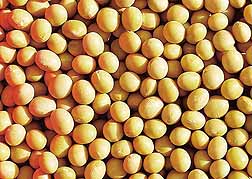This page has been archived and is being provided for reference purposes only. The page is no longer being updated, and therefore, links on the page may be invalid.
|
|
|
|
New Soybean Variety Sets Sights on Japanese Soyfoods Market
By Stephanie YaoDecember 12, 2008
A new small-seed soybean variety that was developed for the lucrative Japanese soyfoods market has been released by Agricultural Research Service (ARS) scientists.
Soybean N8101 was developed by geneticist Thomas Carter and agronomist Joseph Burton at the ARS Soybean and Nitrogen Fixation Research Unit in Raleigh, N.C. It is currently the smallest soybean variety ever released in the United States. N8101 has a yellow seed with shiny luster and clear hilum, the scar formed on the seed when it detaches from the plant. These traits make N8101 physically appealing for commercial use.
N8101 will be harvested and sent to Japan to test the market for its use in the popular breakfast food natto, a traditional dish made from fermented soybeans and normally eaten with rice. Natto is a rich source of protein, but can be an acquired taste due to its pungent smell, strong flavor and sticky consistency.
The ability to absorb water is the first step in the production of natto soyfoods. Although there is no uniform standard, Japanese natto manufacturers prefer soybeans that swell to a greater extent because they generally result in a softer final product. N8101 met this requirement. N8101 also has the potential to be used to supplement the Korean soybean sprout market.
Land for growing crops is scarce in Japan. As a result, Japanese soyfood manufacturers look to other countries to meet their supply needs. The United States is currently one of the world’s largest producers and exporters of soybeans. Last year, the United States produced more than 72 million metric tons of soybeans, and exported more than 31 million metric tons. The bulk of the soybean crop is grown for oil production, with soybean meal used as feed stock. A smaller percentage of the soybean crop is produced for human consumption.
Seed of this release will be deposited in the National Plant Germplasm System, where it will be available for research purposes, including development and commercialization of new cultivars.
A manuscript about the development of N8101 will be published in the Journal of Plant Registrations.
ARS is a scientific research agency of the U.S. Department of Agriculture.


